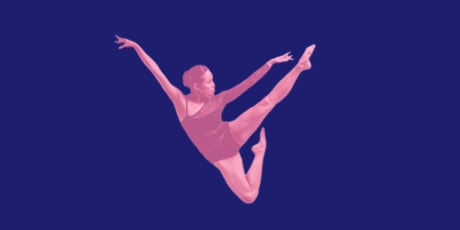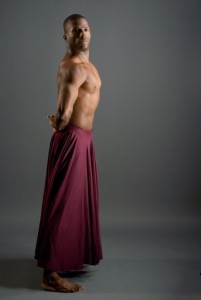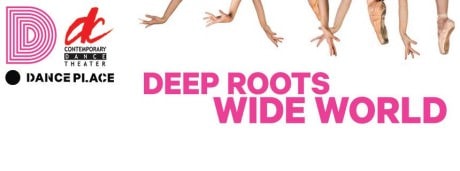“Long title and long history,” said Dance Place Co-Director Deborah Riley to introduce DC Contemporary Dance Theatre, which has also worked under the moniker El Teatro de Danza Contemporanea. Its founder and artistic director Miya Hisaka Silva founded the troupe 30 years ago and yesterday’s celebratory program marked the troupe’s longevity: three decades of making and sharing dance here in Washington and in El Salvador and beyond.

The company’s calling card since 1982 has been diversity in its dancers, its choreographers, even its favored genres. The anniversary program, for example, featured contemporary jazz, a balletic pas de deux danced on pointe, hip hop and African-infused jazz and modern dance.
Company Co-Founder Adrain Bolton, who currently directs a dance ministry in Atlanta, Ga., had two works on the program: 1986’s “Ballet Jazz” and 2013’s “Here and Now.” Both pieces were solid examples of Bolton’s specialty, inspirational jazz technique – the splayed fingered jazz hands, swooping fan kicks, switching hips, rolling shoulders, arcing bent-legged leaps – with a smattering of balletic influence in amplified arabesques and some classic ballet class footwork braided into the works. Both were sunny, feel good dances, the first featuring the music of Jean Luc Ponty, the second, Luther Vandross – and both were adequately though not spectacularly danced.

Maurice Johnson’s hip-hop infused “When the Day Comes,” for Johnson and six dancers, showed off the dancers’ high-energy, fist pounding, heart pumping skills in breaking down and drawing the most out of Johnson’s movement sequences with pulsing hips, pumping contractions, snake-y body rolls and booty shakes.
Reviving Mexican choreographer Gloria Contreras’s challenging pas de deux from 1995 to Mozart’s ‘Adagio K622’ proved challenging for dancers Max Maisey, the evening’s strongest male partner, and Chika Imamura, who lacked both the turnout and the ruler straight balletic line that the choreography demands.
The program’s centerpiece, and the only world premiere, Felipe Oyarzun’s “Amores Secas,” was the most interesting and layered. Dance Place’s Deborah Riley also spoke of the company’s bilinguality – its ability to navigate two nations — the United States and El Salvador – and two cultures. It also tests itself with a multiplicity of embodied dance languages from modern to ballet, jazz to African dance, hip hop to lyrical. There’s an Aileyesque bent to the works and the dancers, not surprising as Hisaka Silva herself has roots in the rigorous Ailey training.
Chilean-trained Oyarzun, currently a graduate student in dance at George Washington University, fuses a vibrant mix of Latin forms in “Amores Secas,” which translates as “Dry Love.” The work is playful, stylish and infused with sensuous tango moves and poses and here the dancers look the most well-rehearsed and comfortable in this playful game of boy-girl tag Oyarzun has set up for five women and three men. One duet unspools when a man in an oversized red sweater encounters his partner and, ultimately, they fuse each with both arms in the sweater until he parts from her. Will Hernandez has the comic task of valiantly and vainly carrying a plastic rose (which lost its top Saturday night) to woo a partner. The appealing mix of heartfelt love songs, ballads and a zesty up tempo number, all Spanish, added spice to the piece.
https://youtu.be/a_PYUs3F3ic
Closing the evening Francisco Castillo and Danilo Rivera’s “Restazos de Vida,” featured six dancers in a high energy, glossy study of the African-Latin root dance forms. With a heavy reliance on percussive snaps, contractions and earthy floor work “Retazos de Vida,” which translates as “Fragments of Life,” brought the program full circle, hearkening back to both the company’s jazz roots and Latin roots. In dance-company years, thirty practically amounts to a lifetime.
Founder Hisaka Silva has been a driving force for multicultural dance in the District and beyond, especially in El Salvador during its post-war reconstruction years, by building a company that doesn’t simply create flashy and fun dances but also works of substance that represent the pain-filled stories and histories of El Salvadorans. It was a shame that none of those works, especially “Y ahora la Esperanza” (“And Now for Hope”), a memorial to El Salvador’s 80,000 war dead – even in excerpt form – were included in this anniversary program, because that’s the lasting legacy that DCCDT and El Teatro de Danza Contemporanea should be known for.
Running Time: 90 minutes with no intermission.
Teatro de Danza Contemporanea performs today, Sunday, February 8, 2015, at 4 PM at Dance Place-3225 8th Street NE, in Washington, DC. Tickets are available at the door only. Tickets are $30 Admission At the Door;$20 Discounted Admission for Dance Place Member; and a $15 Discounted Admission for College Students and Children (17 & under).





